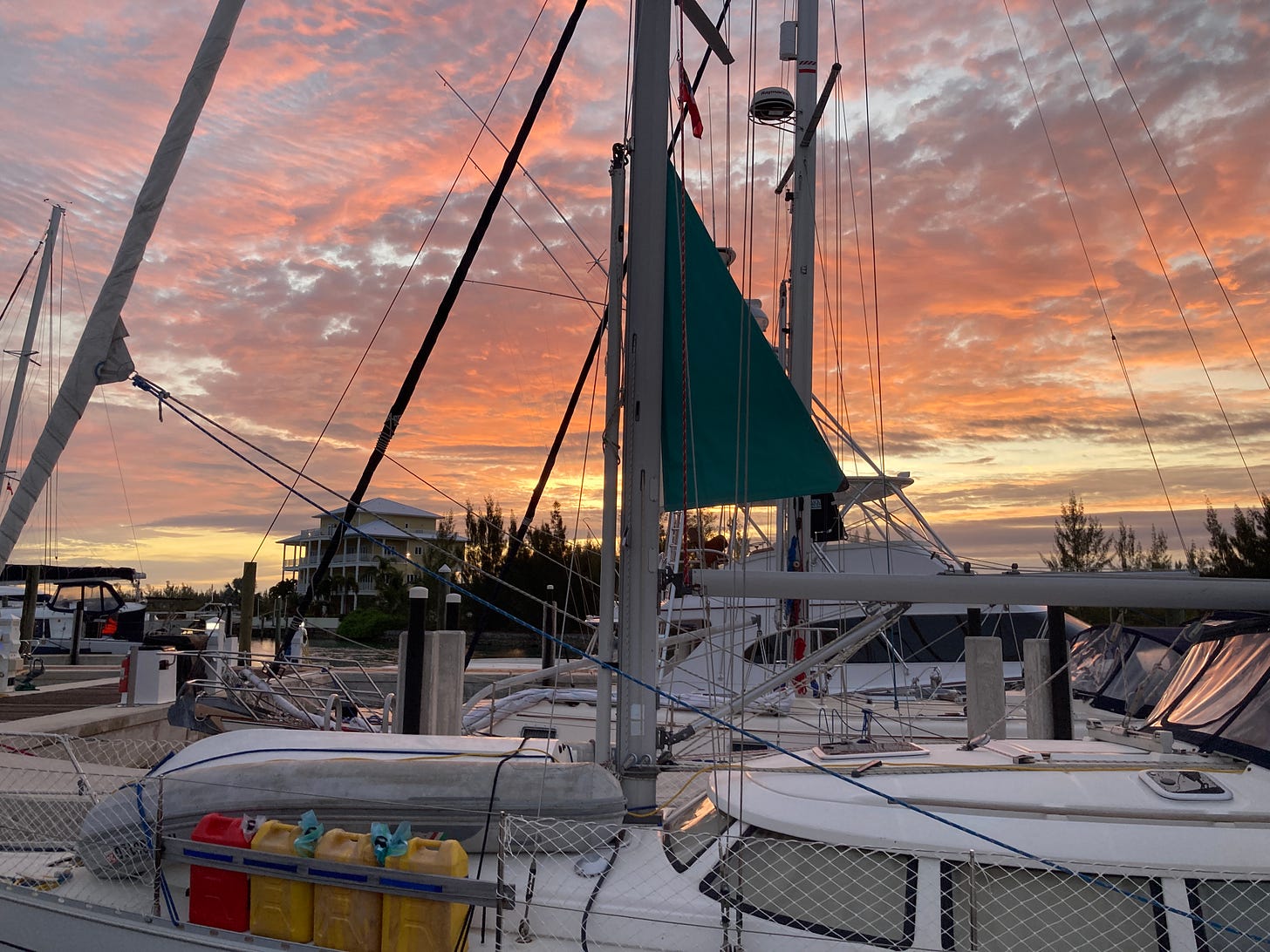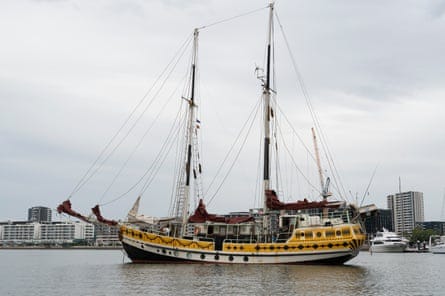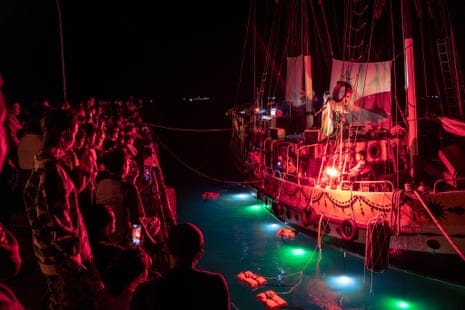I took my sweet time. But last Friday I finally crossed the Gulf Stream to Grand Bahama Island. I sailed only 75 miles, to the port of Lucaya. But that is all it took to find myself in a different country, a different culture, and a different seascape. That is the beauty of life on a sailboat. Your home stays the same, but your reality changes whenever you put up your sails and let the wind take you. Sometimes that reality can be uncomfortable. Many times it is glorious.
I am leaning glorious right now. It has been very windy in Lucaya (and throughout the Bahamas) since I arrived. But the sun has been out, the water is a clear aquamarine, and the temperatures have been perfect. The people I have met so far at the Grand Bahama Yacht Club, where I am holed up for a few days, could not be friendlier or more helpful. The pool is a perfect temperature, and the pool bar has a delicious, spicy vegetable curry. Most important, I am busy plotting my progress south, via the Berry Islands, Nassau, and Exuma. My random but heartfelt goal is still to get to the remote and beautiful Ragged Islands, and then head north again, via Cat and Conception Islands, and then Eleuthera, to end up in the Abacos in March. I am getting so much good advice about where to go and what to do that I am starting to understand a truth already known to many: deep exploration of the Bahamas takes years, not months. Still, I’ll do my best.
The Gulf Stream crossing went about as smoothly as any Gulf Stream crossing can go. I have nothing but respect and awe for the Gulf Stream. It is without question one of most powerful and impactful natural phenomena on the planet, responsible for delivering so much warm water throughout the North Atlantic that it defines the climate as we know it from the East Coast of the United States, to the UK, Ireland and Europe. (Unfortunately, it is not so powerful that it remains unaffected by ongoing climate change; how the Gulf Stream and circulation of other currents in the Atlantic attenuate in coming decades could lead to rapid and catastrophic changes to weather and temperatures all around the Atlantic basin).
I worry about what will happen as the Gulf Stream and other global currents change with warming oceans (if you are not familiar with something known as the AMOC, you will hear more and more about in coming years). But for the purposes of my jump from West Palm Beach to the Bahamas, the most salient aspect of the Gulf Stream is that it is at its most concentrated and powerful…between Florida and the Bahamas. As you can see above, it is a firehose of warm water shooting north just off the Florida coast. Any moderate or stronger winds from the northern quadrant, pushing against 3 knots of current, will create short, steep seas that inflict misery on a boat and crew. Finding the right weather window to make the quick jump across this fast-moving conveyor belt is the key to a safe and comfortable passage.
I know, because when I was in college my friends and I chartered a 31-foot Pearson sailboat from Fort Lauderdale to spend spring break in the Bahamas. Being young, dumb, and immortal, we didn’t bother to learn anything about crossing the Gulf Stream and without a second thought sailed out into it during a hard norther. We found steep, 8-foot waves, some breaking, and got the absolute sh*t kicked out of us. We were smart enough, thankfully, to beat a hasty retreat to the Intra-Coastal Waterway, most of us puking over the side.
We then motored north for a day, drinking cocktails and looking into the living rooms of waterside mansions, until we arrived at Palm Beach and tried again. Luckily, by then the wind had eased a bit, and we took the remaining big seas on the beam when we crossed, rather than on the nose. We managed to find West End in the Bahamas, thanks to a half-working radio direction finder, and had a great time in the Abacos for a week even though the engine stopped working, we touched bottom not infrequently, and ran out of food a full day before we made it back to Florida. Whenever I recall that epic, foolhardy, and thoroughly enjoyable cruise I think of Joseph Conrad’s Youth, one of my favorite short stories: “Ah! The good old time—the good old time. Youth and the sea. Glamour and the sea! The good, strong sea, the salt, bitter sea, that could whisper to you and roar at you and knock your breath out of you.”
I would trade aged wisdom for carefree youth in an instant, but since I can’t for this Gulf Stream crossing I patiently waited in West Palm beach for the right moment, which arrived in the form of light and variable winds from the southwest, clocking to the west and then northwest. My friend Bobby from Saint Simons Island came down to Palm Beach to join me, and we hauled the anchor and set off around 9 pm, on the last of the ebb. The Gulf Stream was benign, with 2-3 foot waves and mostly clear skies under a brilliant half moon. We sailed off the wind and motor-sailed as needed to make a fast crossing. And the only hiccup in an otherwise pleasant passage was a sudden and unforecast rapid strengthening of the wind, along with an abrupt shift from the southwest to the northwest, which caught me napping. The result was an unintended gybe that fetched the boom up hard against the checkstay. No damage was done, thankfully, because I had the Boom Brake snugged down and the winds weren’t that strong. But it was a good reminder that the Gulf Stream always has a trick or two ready to surprise you. And that on a sailboat it is hard to anticipate and preclude any and every little mishap. Sh*t always and eventually happens. The key is to avoid catastrophe.
The sun came up as we exited the Gulf Stream, and we were in a new, island-nation, world. The water was a deep azure, and then a welcoming turquoise as we approached the cut into Lucaya. We could easily see the bottom in water that was 20 feet deep. The shoreline, once past the industrial chaos of Freeport, was all beach and dotted with colorful houses and resorts. The air felt warmer, the breeze friendlier. We backed into a slip at Grand Bahama Yacht Club, and I cleared in without hassle or incident at the customs office on the fuel dock. The passage and Gulf Stream crossing had been brief and successful. Laughing Gull was officially in the Bahamas, with a 3-month cruising permit. This time, I’ll try not to run aground too often. This time, I’ll try not to run out of food. But I absolutely will try to have as much fun as I did when I was in these same waters at the age of 20. I’m off to a good start.
Worth Reading: The Guardian chronicles the voyage of two musicians sailing the planet to inspire audiences to think about the climate and how they can live differently. What an excellent idea! (h/t to Michael for sending this to me)
Here is the gist:
As musicians and activists, both were frustrated by the environmental impact of touring. A 2010 study found that three-quarters of greenhouse gas emissions produced by the music industry came from live performances; in 2009 it was estimated that U2’s world tour had the equivalent carbon footprint of a return flight to Mars. In the decade since, musicians including Harry Styles, the 1975 and Coldplay have attemped to mitigate the impact of their tours by introducing measures including tree-planting initiatives, using solar power for their stages and upcycling merch.
Filastine and Nova eventually found a method to match their message: they sold their share in a house in Seattle and borrowed money to buy the Arka Kinari, a battered old schooner that they refitted in Rotterdam. Ever since, they have sailed around the world, performing at festivals – including Sydney festival next week and Mona Foma in Tasmania in February – as well as stopping in at tiny fishing villages and seaside towns, where locals are invariably curious.
“Usually they ask us, ‘Why are you doing this? It must be so difficult.’ That’s when we bring up climate change – we ask them if they have been impacted by it. So often they will have stories,” says Filastine.
It isn’t easy, though, and this part resonates deeply as well:
Does Filastine ever get frustrated that more touring acts don’t try to be more green? “Arka Kinari is a strange mix of practical and romantic,” he replies. “It’s meant to inspire – an almost impossible thing that is being done … But at what cost? A slowness that would drive many crazy. It’s very precarious, we’re just barely getting by. And a dependency on the whims of nature – the wind, currents and tides rule our lives in a way that most of us have completely forgotten.”
I would argue that reconnecting with nature and living more according to its rhythms is actually the key to addressing the existential threats we face. Once you commit to the idea that we are part of Nature, and should live in harmony with it rather than negating and dominating it (and destroying it) with technology, consumption, and combustion, it is easier to see a future in which both humans and the planet thrive together.
Last Word: Hard to argue (via)…
If you liked this post from Sailing Into The Anthropocene, why not subscribe here (free!), and/or hit that share button below? You can also find me on Instagram and Twitter.










